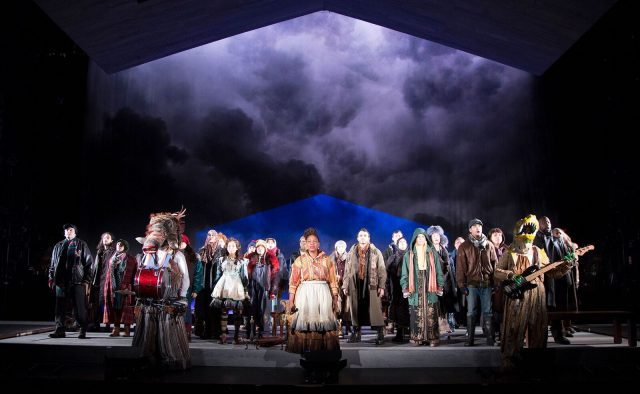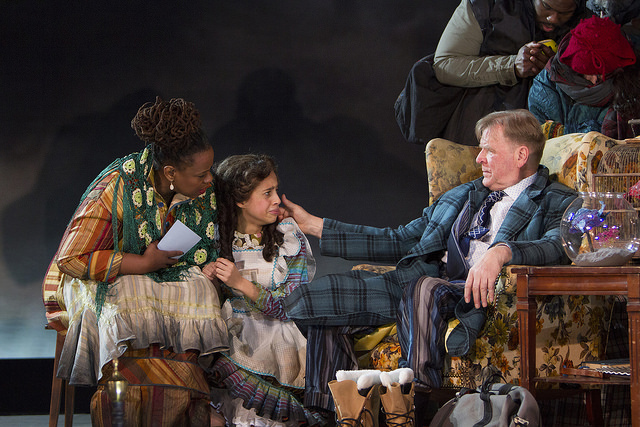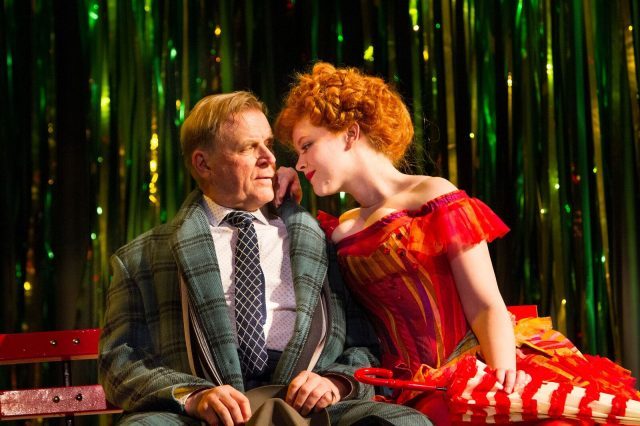
TFANA revival of Thornton Wilder’s THE SKIN OF OUR TEETH balances doom and gloom with hope and faith (photo by Henry Grossman)
Theatre for a New Audience, Polonsky Shakespeare Center
262 Ashland Pl. between Lafayette Ave. & Fulton St.
Tuesday – Sunday through March 19, $60-$110
866-811-4111
www.tfana.org
For the uninitiated, Thornton Wilder’s The Skin of Our Teeth, running in an exhilarating revival at Theatre for a New Audience through March 19, may come as quite a shock, a complex, unpredictable, boundary-shattering exploration of the human experience over millennia from the man most famous for Our Town. “The remarkable thing is how we forget, again and again. We forget Wilder’s vision and voice; in our memory we assign his works to a nostalgic theater of our youth, encountered first in high school, in community theater, in assigned work judged to be inoffensive enough to constitute the canon for young readers,” Pulitzer Prize-winning playwright Paula Vogel explains in the foreword to the 2003 Perennial Classics edition of the play. “And then we encounter him on stage as he is and will remain through the ages: tough-minded, exacting, facing the darkness in human existence without apology.” Professor, novelist, actor, and screenwriter Wilder won the last of his three Pulitzer Prizes — he won the fiction award for the novel The Bridge of San Luis Rey in 1928 and his first drama prize in 1938, for Our Town — for The Skin of Our Teeth, the wild and wacky story of the Antrobus clan as it survives the Ice Age, the biblical flood, and a world war. Wilder wrote the play during WWII, worried about the possible outcome but showing faith and hope in humanity’s natural will to survive; in fact, the Antrobuses, who live in Excelsior, New Jersey, are named after “anthropos,” the Greek word for “human.”

The Antrobus family fights crises both existential and real at Theater for a New Audience (photo by Henry Grossman)
Mr. George Antrobus (David Rasche) is the inventor of the alphabet, the multiplication table, and the wheel; he’s been married for five thousand years to Mrs. Maggie Antrobus (Kecia Lewis), and they have two children, Gladys (Kimber Monroe) and Henry (Reynaldo Piniella). They also have a loud, sexy maid, Lily Sabina (Mary Wiseman), who regularly quits when things don’t go her way, and a pair of prehistoric pets, a dinosaur (Fred Epstein) and a mammoth (Eric Farber). The family makes its way through a series of global crises, an Atlantic City beauty contest, a refugee invasion, a doom-preaching fortune-teller (Mary Lou Rosato), and even Homer (Andrew R. Butler) and Moses (Robert Langdon Lloyd), all the while breaking character and speaking directly to the audience, sometimes as the actor playing the actor playing the role. The show begins with Sabina alone onstage, delivering a monologue about the life and times of the Antrobuses while cleaning up; however, she has to repeat a line about the depression several times as it becomes apparent that another actor has missed their cue, breaking that fourth wall immediately. Out of sight, the stage manager, Mr. Fitzpatrick (William Youmans), tells her, “Make up something! Invent something!” Instead, as Miss Somerset, the actress playing Sabina, she boldly proclaims, “I hate this play and every word in it. As for me, I don’t understand a single word of it, anyway.” For the next two and a half hours, the actors, the actors they’re playing, and the characters they’re playing continually go “off script” to one another and to the audience, including a riotous scene in which Mr. Fitzpatrick must suddenly recast a handful of roles because of illness, needing bodies to recite philosophical musings by Aristotle, Plato, and Spinoza as the planets. Of course, every deviation from the standard, traditional nature of storytelling is carefully choreographed by Wilder and director Arin Arbus.

Lily Sabina (Mary Wiseman) has the hots for her boss, George Antrobus (David Rasche), in Thornton Wilder revival (photo by Henry Grossman)
The Skin of Our Teeth debuted on Broadway in 1942, directed by Elia Kazan and starring Fredric March as Mr. Antrobus, Florence Eldridge as Mrs. Antrobus, Montgomery Clift as Henry, Frances Heflin as Gladys, Tallulah Bankhead as Sabina, E. G. Marshall as Mr. Fitzpatrick, and Dickie Van Patten as the telegraph boy. Wilder was inspired and influenced by the works of Bertolt Brecht, Luigi Pirandello, Gertrude Stein, the German Expressionists, and, primarily, James Joyce and Finnegan’s Wake. The play contains a nearly endless stream of references, particularly biblical (George and Maggie as Adam and Eve, Sabina as Lilith, Henry as Cain), while also attacking subjects that are as relevant today as they were seventy-four years ago, including climate change, war, education, religion, and the refugee crisis. As Vogel also writes, “Regardless of how his characters speak, it is what his characters say that remains timeless.” TFANA associate artistic director Arbus (A Doll’s House, The Father) takes full advantage of the theater, as the cast of nearly three dozen makes its way through the audience and the upper balcony. Riccardo Hernandez’s phenomenal set is centered by two side walls and a roof gable that forms the Antrobus’s open house, which goes through a dazzling change later in the show. César Alvarez’s original music includes a song near the end that is one of the only elements that feels out of place. The play itself has its problems, but this splendid production sweeps most of them aside. “The theatric invention must tirelessly transform every fragment of dialogue into a stylization surprising, comic, violent, or picturesque,” Wilder wrote about the play in his 1940 notebook. This revival of The Skin of Our Teeth does all that and more.